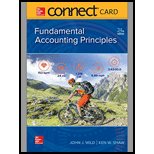
Connect Access Card For Fundamental Accounting Principles
24th Edition
ISBN: 9781260158526
Author: John J Wild
Publisher: McGraw-Hill Education
expand_more
expand_more
format_list_bulleted
Concept explainers
Textbook Question
Chapter 22, Problem 18E
Exercise 22-18
Budgeted cash receipts
P2
Jasper company has sales on account and for cash. Specifically, 70% of its on account and 30% are for cash. Credit sales are collected in full in the month following the sale. The company
Expert Solution & Answer
Want to see the full answer?
Check out a sample textbook solution
Students have asked these similar questions
Please help me solve this general accounting problem with the correct financial process.
None
What's the Solution?
Chapter 22 Solutions
Connect Access Card For Fundamental Accounting Principles
Ch. 22 - Prob. 1DQCh. 22 - Prob. 2DQCh. 22 - 3. What is the benefit of continuous budgeting?
Ch. 22 - 4. Identify three usual time horizons for...Ch. 22 - 5. Why should each department participate in...Ch. 22 - Prob. 6DQCh. 22 - Prob. 7DQCh. 22 - Prob. 8DQCh. 22 - Prob. 9DQCh. 22 - Prob. 10DQ
Ch. 22 - Prob. 11DQCh. 22 - Prob. 12DQCh. 22 - Prob. 13DQCh. 22 - Prob. 14DQCh. 22 - Prob. 15DQCh. 22 - Prob. 16DQCh. 22 - Budget motivation C1 For each of the following...Ch. 22 - Prob. 2QSCh. 22 - Prob. 3QSCh. 22 - Prob. 4QSCh. 22 - Prob. 5QSCh. 22 - Prob. 6QSCh. 22 - Prob. 7QSCh. 22 - Prob. 8QSCh. 22 - Prob. 9QSCh. 22 - Prob. 10QSCh. 22 - Prob. 11QSCh. 22 - Prob. 12QSCh. 22 - Prob. 13QSCh. 22 - Prob. 14QSCh. 22 - Prob. 15QSCh. 22 - Prob. 16QSCh. 22 - Prob. 17QSCh. 22 - Prob. 18QSCh. 22 - Prob. 19QSCh. 22 - QS 22-20
Cash receipts, with uncollectible...Ch. 22 - Cash receipts, with uncollectible accounts P2...Ch. 22 - Prob. 22QSCh. 22 - Prob. 23QSCh. 22 - Prob. 24QSCh. 22 - Prob. 25QSCh. 22 - Prob. 26QSCh. 22 - Prob. 27QSCh. 22 - Prob. 28QSCh. 22 - Prob. 29QSCh. 22 - Prob. 30QSCh. 22 - Prob. 31QSCh. 22 - Prob. 1ECh. 22 - Prob. 2ECh. 22 - Prob. 3ECh. 22 - Prob. 4ECh. 22 - Prob. 5ECh. 22 - Prob. 6ECh. 22 - Prob. 7ECh. 22 - Prob. 8ECh. 22 - Prob. 9ECh. 22 - Prob. 10ECh. 22 - Prob. 11ECh. 22 - Prob. 12ECh. 22 - Prob. 13ECh. 22 - Prob. 14ECh. 22 - Prob. 15ECh. 22 - Prob. 16ECh. 22 - Prob. 17ECh. 22 - Exercise 22-18 Budgeted cash receipts P2 Jasper...Ch. 22 - Prob. 19ECh. 22 - Prob. 20ECh. 22 - Prob. 21ECh. 22 - Prob. 22ECh. 22 - Exercise 22-23
Manufacturing: Cash...Ch. 22 - Prob. 24ECh. 22 - Prob. 25ECh. 22 - Prob. 26ECh. 22 - Prob. 27ECh. 22 - Prob. 28ECh. 22 - Prob. 29ECh. 22 - Prob. 30ECh. 22 - Prob. 31ECh. 22 - Exercise 22-32A
Merchandising: Cash...Ch. 22 - Exercise 22-33A
Merchandising: Budgeted balance...Ch. 22 - Prob. 34ECh. 22 - Prob. 35ECh. 22 - Prob. 1APSACh. 22 - Prob. 2APSACh. 22 - Prob. 3APSACh. 22 - Problem 22-4A Manufacturing: Preparation of a...Ch. 22 - Prob. 5APSACh. 22 -
Problem 22-6AA
Merchandising: Preparation of...Ch. 22 - Prob. 7APSACh. 22 - Prob. 8APSACh. 22 - Prob. 1BPSBCh. 22 - Prob. 2BPSBCh. 22 - Prob. 3BPSBCh. 22 - Problem 22-4B Manufacturing: Preparation of a...Ch. 22 - Prob. 5BPSBCh. 22 - Prob. 6BPSBCh. 22 - Prob. 7BPSBCh. 22 - Prob. 8BPSBCh. 22 - Prob. 22SPCh. 22 - Prob. 1AACh. 22 - Prob. 2AACh. 22 - Prob. 3AACh. 22 - Both the budget process and budgets themselves can...Ch. 22 - BTN 22-4 The sales budget is usually the first and...Ch. 22 - Certified Management Accountants must understand...Ch. 22 - Prob. 4BTNCh. 22 - Prob. 5BTNCh. 22 - To help understand the factors impacting a sales...
Knowledge Booster
Learn more about
Need a deep-dive on the concept behind this application? Look no further. Learn more about this topic, accounting and related others by exploring similar questions and additional content below.Similar questions
- I need help with accountingarrow_forwardMeryl Manufacturing had a Work-in-Process balance of $168,000 on January 1, 2023. The year-end balance of Work-in-Process was $192,000, and the Cost of Goods Manufactured was $745,000. Use this information to determine the total manufacturing costs incurred during the fiscal year 2023.arrow_forwardThe following is budgeted per-unit information for 2021:arrow_forward
arrow_back_ios
SEE MORE QUESTIONS
arrow_forward_ios
Recommended textbooks for you
 Fundamentals of Financial Management (MindTap Cou...FinanceISBN:9781285867977Author:Eugene F. Brigham, Joel F. HoustonPublisher:Cengage Learning
Fundamentals of Financial Management (MindTap Cou...FinanceISBN:9781285867977Author:Eugene F. Brigham, Joel F. HoustonPublisher:Cengage Learning Cornerstones of Financial AccountingAccountingISBN:9781337690881Author:Jay Rich, Jeff JonesPublisher:Cengage Learning
Cornerstones of Financial AccountingAccountingISBN:9781337690881Author:Jay Rich, Jeff JonesPublisher:Cengage Learning Fundamentals of Financial Management, Concise Edi...FinanceISBN:9781305635937Author:Eugene F. Brigham, Joel F. HoustonPublisher:Cengage Learning
Fundamentals of Financial Management, Concise Edi...FinanceISBN:9781305635937Author:Eugene F. Brigham, Joel F. HoustonPublisher:Cengage Learning Fundamentals of Financial Management, Concise Edi...FinanceISBN:9781285065137Author:Eugene F. Brigham, Joel F. HoustonPublisher:Cengage Learning
Fundamentals of Financial Management, Concise Edi...FinanceISBN:9781285065137Author:Eugene F. Brigham, Joel F. HoustonPublisher:Cengage Learning Managerial AccountingAccountingISBN:9781337912020Author:Carl Warren, Ph.d. Cma William B. TaylerPublisher:South-Western College Pub
Managerial AccountingAccountingISBN:9781337912020Author:Carl Warren, Ph.d. Cma William B. TaylerPublisher:South-Western College Pub Financial & Managerial AccountingAccountingISBN:9781285866307Author:Carl Warren, James M. Reeve, Jonathan DuchacPublisher:Cengage Learning
Financial & Managerial AccountingAccountingISBN:9781285866307Author:Carl Warren, James M. Reeve, Jonathan DuchacPublisher:Cengage Learning

Fundamentals of Financial Management (MindTap Cou...
Finance
ISBN:9781285867977
Author:Eugene F. Brigham, Joel F. Houston
Publisher:Cengage Learning

Cornerstones of Financial Accounting
Accounting
ISBN:9781337690881
Author:Jay Rich, Jeff Jones
Publisher:Cengage Learning

Fundamentals of Financial Management, Concise Edi...
Finance
ISBN:9781305635937
Author:Eugene F. Brigham, Joel F. Houston
Publisher:Cengage Learning

Fundamentals of Financial Management, Concise Edi...
Finance
ISBN:9781285065137
Author:Eugene F. Brigham, Joel F. Houston
Publisher:Cengage Learning

Managerial Accounting
Accounting
ISBN:9781337912020
Author:Carl Warren, Ph.d. Cma William B. Tayler
Publisher:South-Western College Pub

Financial & Managerial Accounting
Accounting
ISBN:9781285866307
Author:Carl Warren, James M. Reeve, Jonathan Duchac
Publisher:Cengage Learning
The management of receivables Introduction - ACCA Financial Management (FM); Author: OpenTuition;https://www.youtube.com/watch?v=tLmePnbC3ZQ;License: Standard YouTube License, CC-BY